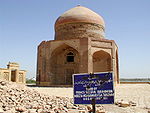This article lists the sites registered with World Heritage to Pakistan.
Understand
the Pakistan ratify the Convention for the Protection of the World Cultural and Natural Heritage on . The first protected sites were inscribed in 1980.
the Pakistan has 6 sites registered with World Heritage, cultural.
The country has also submitted 18 sites to the tentative list, cultural.
Listing
The following sites are listed as World Heritage.
| Site | Type | Criterion | Description | Drawing | |||||||||||||||||||||
|---|---|---|---|---|---|---|---|---|---|---|---|---|---|---|---|---|---|---|---|---|---|---|---|---|---|
| 1 Rohtas Fort | Cultural | (ii), (iv) | After defeating the Mughal Emperor Humayun in 1541, Sher Shah Suri built a set of defensive works at Rohtas, a strategic site in the north of present-day Pakistan. The fort of Rohtas was never stormed and remains intact today. The main fortifications consist of massive walls that extend over more than 4 km ; they have bastions and are pierced with monumental gates. The Fort of Rohtas, or Qila Rohtas, is an outstanding example of the beginnings of Muslim military architecture in this region of Asia. |  | |||||||||||||||||||||
| 2 Fort and Shalimar Gardens in Lahore | Cultural | (i), (ii), (iii) | These are two masterpieces of the brilliant Mughal civilization at its peak, during the time of Emperor Shah Jahan. Lahore Fort contains palaces and marble mosques, adorned with mosaics and gilding. Close to the city, the marvelous Shalimar gardens spread over three terraces, with pavilions, waterfalls and vast ponds, are of unparalleled refinement. |  | |||||||||||||||||||||
| 3 Historical monuments in Makli, Thatta | Cultural | (iii) | Capital of three successive dynasties, then possession of the Mughal emperors of Delhi, Thatta has continued to be embellished with XIVe to XVIIIe century. The remains of the city and its necropolis offer a unique testimony to the civilization of Sindh. |  | |||||||||||||||||||||
| 4 Archaeological ruins of Mohenjo Daro | Cultural | (ii), (iii) | This site preserves the ruins of a huge city in the Indus Valley, built entirely in mud brick and dating back to the IIIe millennium BC Its acropolis, raised on enormous embankments, its ramparts and the rigor of the plan of its lower town testify to a strictly planned town planning. |  | |||||||||||||||||||||
| Buddhist ruins of Takht-i-Bahi and remains of Sahr-i-Bahlol 5 Takht-i-Bahi 6 Sahr-i-Bahlol | Cultural | (iv) | The whole of the Buddhist monastery of Takht-i-Bahi (or "throne of the source") was founded at the beginning of the Ier century. Thanks to its location on the crest of a high hill, it escaped successive invasions, which explains its exceptional state of preservation. The nearby ruins of Sahr-i-Bahlol bear witness to the presence of a small fortified town dating from the same period. |  | |||||||||||||||||||||
| 7 Taxila | Cultural | (iii), (vi) | From the very old neolithic tumulus of Saraikala to the ramparts of Sirkap, dating from the IIe century BC AD, and the city of Sirsukh, from the Ier century apr. J. - C., Taxila illustrates the stages of the urban development of a city of Indus subjected in turn to the influences of Persia, the Hellenic world and Central Asia, and which, of the VIe century BC AD to IIe century of the Christian era, was the seat of a flourishing Buddhist university. |  | |||||||||||||||||||||
Criteria legend
| |||||||||||||||||||||||||
